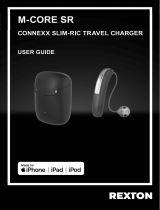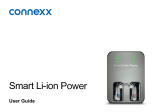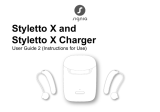Page is loading ...

Click Dome
Smart Transmitter
User Guide

2
Content
Before you art 3
Included in delivery 4
Components 4
Getting arted 5
Connecting to power supply 5
Connecting to audio devices 6
Pairing the transmitter 7
Daily use 8
Using the transmitter 8
LED atus indication 9
Important safety information 11
Personal safety 11
Product safety 13
Important information 15
Explanation of symbols 15
Maintenance and care 16
Disposal information 16
Conformance information 16

3
Before you art
The transmitter is an accessory for our remote controls
with audio reaming capability. The transmitter connects
TV, ereo, or MP3 player as well as many other
electronic devices without Bluetooth®* functionality to the
remote control for your hearing inruments. Using the
transmitter you will wirelessly ream sounds directly into
the hearing inruments.
CAUTION
Read this user guide thoroughly and completely
and follow the safety information in this document
to avoid damage or injury.
* The Bluetooth word mark and logos are owned by the Bluetooth SIG, Inc., and any
use of such marks by Sivantos GmbH is under licenses. Other trademarks and trade
names are those of their respective owners.

4
Included in delivery
■ Transmitter
■ Power plug with dierent adapters
■ USB power cable
■ Audio cable with 3.5 mm ereo plugs
■ Adapter RCA (cinch) to 3.5 mm ereo socket
■ TOSLINK cable
Components
➊
On/o button
➋
LED atus indicator
(green, blue, orange)
➌
Volume buttons
➍
TOSLINK connection
➎
Connection for andard
line‑in devices with
3.5 mm audio jack
➏
USB port for power supply

5
Getting arted
Connecting to power supply
NOTICE
Please make sure that the power plug is easily
accessible to remove it from power supply if
necessary.
Only use the USB power cable and power adapter that
came with the device. Select the adapter that is used in
your country.
XConnect the micro USB side of the USB power cable
to the transmitter ➊.
XConnect the other side of the USB power cable to the
power plug ➋.
XConnect the power plug to the power supply ➌.

6
Connecting to audio devices
Use the supplied cables and adapters.
Further information:
■ When using the TOSLINK cable:
□ Before connecting the cable, remove the protection
caps from the TOSLINK cable plugs.
□ To prevent the TOSLINK cable from breaking, do
not forcefully bend it.
□ Set the output format of the TV or audio
device to "uncompressed PCM audio"
(PCM = pulse-code modulation).
Compressed audio format (like surround sound)
is not supported by the transmitter. This will be
indicated by a flashing orange LED .
■ If the two inputs of the transmitter are connected to
dierent audio devices, the device connected via
TOSLINK cable has the higher priority and the audio

7
signal of this device will be reamed to your hearing
inruments. The audio signal of the other device will
not be reamed.
Pairing the transmitter
The remote control for your hearing inruments has to be
paired once with the transmitter.
XFollow the inructions in the remote control's user
guide.

8
Daily use
Using the transmitter
XCheck if the green LED shines (transmitter
is turned on and ready for audio reaming).
If the green LED is o, press to turn the transmitter
on.
XTo art audio reaming, use the remote control for
your hearing inruments: Set up the remote control for
your hearing inruments so that audio reaming with
our transmitters is active. Follow the inructions in the
remote control's user guide.
When the blue LED shines , audio reaming
is active.
XTo adju the volume of the reamed audio signal,
press (volume up) or (volume down) on the
transmitter.
You can also adju the volume with the remote control
for your hearing inruments or with the controls of
your hearing inruments.
If you intend not to use the transmitter for a longer period
of time, you can turn it o by pressing .

9
LED status indication
Green LED on
➧ Transmitter is on. It is ready for pairing
or audio reaming.
Green LED o
➧ Transmitter is o.
The blue LED shows the atus of the Bluetooth
connection between transmitter and remote control
for your hearing inruments.
Blue LED on
➧ Audio reaming is active.
Blue LED o
➧ No audio reaming is active.

10
The orange LED shows the atus of the TOSLINK
connection.
Steady orange light
➧ TOSLINK cable is connected and audio
signal in the required format is available. Refer
to section "Connecting to audio devices".
Flashing
➧ TOSLINK cable is connected, but the audio
signal has the wrong format. Refer to section
"Connecting to audio devices".
Orange LED o
➧ No TOSLINK cable is connected or the cable
is not connected properly.
➧ TV or audio device is switched o.
➧ TOSLINK cable is broken.

11
Important safety information
Personal safety
WARNING
Choking hazard!
Your device contains small parts which can be
swallowed.
XKeep hearing inruments, batteries and
accessories out of reach of children and
mentally disabled persons.
XIf parts have been swallowed consult a physician
or hospital immediately.
WARNING
Risk of electrical shock!
XDo not use obviously damaged devices and
return them to point of sale.
WARNING
Note that any unauthorized changes to the product
may cause damage to the product or cause injury.
XUse only approved parts and accessories. Ask
your Hearing Care Professional for support.

12
WARNING
Risk of electric shock!
XConnect audio input only to a device conforming
to IEC 60065, the IEC-Norm for audio, video and
other electronic devices.
WARNING
Interference with implantable devices
XThe device can be used with all
electronic implants that comply with the
ANSI/AAMI/ISO 14117:2012 Electromagnetic
compatibility andard for human implants.
XIn case your implant does not comply with the
ANSI/AAMI/ISO 14117:2012 andard, consult
the manufacturer of your implantable device for
information about the risk of diurbance.
WARNING
This device may interfere with measuring and
electronic equipment.
XDo not use your device on airplanes or areas
where sensitive or life‑supporting electronic
equipment is used.
WARNING
Risk of explosion!
XDo not use your device in explosive
atmospheres (e. g. in mining areas).

13
Product safety
NOTICE
XProtect your devices from extreme heat. Do not
expose them to direct sunlight.
NOTICE
XProtect your devices from high humidity.
NOTICE
XDo not dry your devices in the microwave oven.
NOTICE
Dierent types of rong radiation, e. g. during
X‑ray or MRI head examinations, may damage
devices.
XDo not use the devices during these or similar
procedures.
Weaker radiation, e. g. from radio equipment or
airport security, does not damage the devices.
In some countries rerictions for the usage of
wireless equipment exi.
XRefer to local authorities for further information.

14
NOTICE
Your hearing inruments are designed to comply
with international andards on electromagnetic
compatibility but interference with nearby electronic
devices could occur. In this case, move away from
the source of interference.

15
Important information
Explanation of symbols
Symbols used in this document
Points out a situation that could lead to serious,
moderate, or minor injuries.
Indicates possible property damage.
Advice and tips on how to handle your device better.
Symbols on the device or packaging
CE compliance label, conrms compliance with
certain European Directives, refer to section
"Conformance information".
EMC and radio communications
compliance label Auralia, refer to section
"Conformance information".
Indicates the legal manufacturer of the device.
Do not dispose of the device with general
domeic wae. Read more in section
"Disposal information".
Read and follow the inructions in the user
guide.

16
Maintenance and care
NOTICE
XDo not put your device in water!
XDo not clean your device with
alcohol or benzine.
X Clean the device as necessary with a soft tissue.
XAvoid abrasive cleaning liquids with additives such as
citric acids, ammonia, etc.
Disposal information
Recycle devices, accessories and packaging according
to local regulations.
Conformance information
The CE mark indicates conformity with the following
European directives:
■ 2014/30/EU concerning electromagnetic compatibility
■ 2014/35/EU concerning electrical equipment designed
for use within certain voltage limits
■ 2014/53/EU (RED) concerning radio equipment
■ 2011/65/EU RoHS concerning the reriction of
hazardous subances

17
Wireless functionality
FCC: QWOB8Z869
IC: 4460A-B8Z869
FCC and ISED compliance information can be found on
the back of the device.
The ACMA compliance mark indicates conformity
with the electromagnetic interference andards set by
the Auralian Communications and Media Authority
(ACMA).
Devices with the FCC marking comply with the andards
of the FCC regarding electromagnetic interference.
This Class B digital apparatus complies with Canadian
ICES-003.
This device complies with Part 15 of the FCC Rules and
with ISED's licence-exempt RSSs.
Operation is subject to the following two conditions:
■ This device may not cause harmful interference, and
■ this device mu accept any interference received,
including interference that may cause undesired
operation.
This equipment has been teed and found to comply
with the limits for a Class B digital device, pursuant to
Part 15 of the FCC Rules. These limits are designed
to provide reasonable protection again harmful

18
interference in a residential inallation. This equipment
generates, uses and can radiate radio frequency energy
and, if not inalled and used in accordance with the
inructions, may cause harmful interference to radio
communications. However, there is no guarantee that
interference will not occur in a particular inallation. If
this equipment does cause harmful interference to radio
or television reception, which can be determined by
turning the equipment o and on, the user is encouraged
to try to correct the interference by one or more of the
following measures:
■ Reorient or relocate the receiving antenna.
■ Increase the separation between the equipment and
receiver.
■ Connect the equipment to an outlet on a circuit
dierent from that to which the receiver is connected.
■ Consult the dealer or an experienced radio/TV
technician for help.
FCC caution: Any changes or modications not expressly
approved by the party responsible for compliance could
void the user's authority to operate this equipment.
This transmitter mu not be co-located or operating in
conjunction with any other antenna or transmitter.

19
Radiation exposure atements
This equipment complies with FCC and ISED radiation
exposure limits set forth for an uncontrolled environment.
This equipment should be inalled and operated with
a minimum diance of 20 cm between the radiator and
your body.
Bluetooth radio frequency band
All channels supported from 2402 MHz to
2480 MHz with channel centers at every 1 MHz
(2402 MHz, ..., 2479 MHz, 2480 MHz) i.e. 79 channels.

www.sivantos.com
Document No. 02993-99T01-7600 EN
Order/Item No. 109 407 70
Master Rev01, 06.2016
© Sivantos GmbH, 07.2016
Legal Manufacturer
Sivantos GmbH
Henri-Dunant-Strasse 100
91058 Erlangen
Germany
Phone +49 9131 308 0
/











